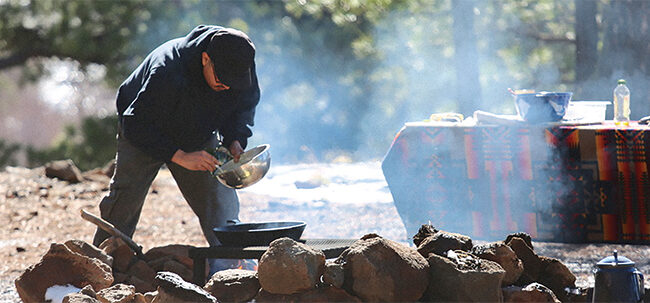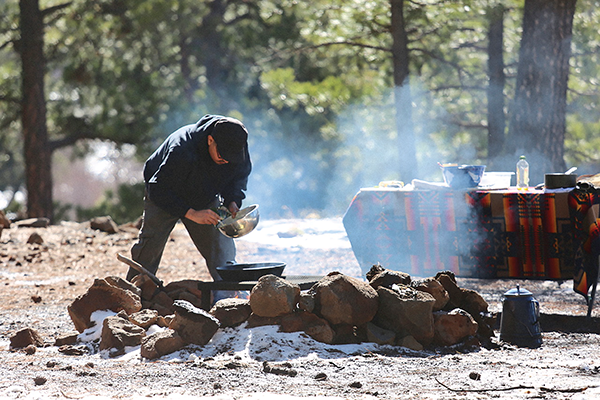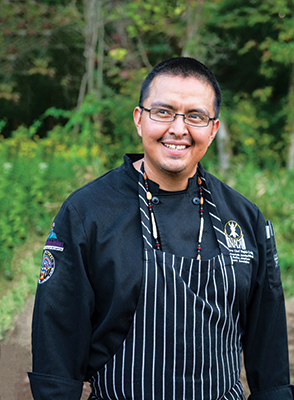Western Apacheria
A people and landscape in recovery
 Nephi Craig, cooking in the White Mountains at about 10,000 feet, in the spring. Photograph by Reggie McVeigh.
Nephi Craig, cooking in the White Mountains at about 10,000 feet, in the spring. Photograph by Reggie McVeigh.
BY NEPHI CRAIG
LAND
Landscape is destiny. As Indigenous peoples, we represent our landscapes. Basically, landscape is destiny means that you are your landscape. The ancestral knowledge that a particular culture stands on originated in the lessons and behaviors of the landscape. Understanding how our land behaves requires an intimate relationship with land, waters, food, farming, people, and the cosmos. Our people are grouped by the term Western Apache, which consists of the Tonto, Yavapai, San Carlos, and my tribe, the White Mountain Apache. The White Mountain Apache Tribe is located in northeastern Arizona where we experience all four seasons, and our ancestral landscape offers a diverse array of both wild and cultivated flora and fauna, all of which have evolved our culture while also providing food, medicine, health, waters, spirit, and a vast array of sciences for our Western Apache people since time immemorial.
Since landscape is destiny, our health and vitality continue to rely on an intimate relationship. We choose to perpetuate this relationship with our landscape in our community through a number of methods, in particular through foraging, agriculture, cooking, and consuming foods. By engaging in these activities, we are able to peer into our past with the help of living plant relatives that provide lessons and flavors that aid in the investigation of and reconstruction of our Western Apache food system and ancestral health. This is the meaningful relationship between time, earth, spirit, and the universe that can fill the void of colonization and physical effects of a fractured relationship with an intelligent food system.
WATER
We are carried and born in water. Our mothers carried us in the safety of the unseen world in water. In our landscape, our mountains cause rain clouds to form—rains fall, and rivers and streams flow while giving life to plants and animals that have taught us life lessons for over thousands of years. It is no wonder why these mountains are sacred places of power for us. The multiple waters flow from our mountain peaks that reach approximately eleven thousand feet into the sky, and flow down to the boundaries of the White Mountain Apache tribal borders, ultimately becoming approximately forty percent of the water that supplies the greater metropolitan area of Phoenix, Arizona. Our waters are sacred and sustain millions of people in the Southwest. The waters from our White Mountains provide seasonal vitality in the form of wild food plants, wild medicine plants, and the waters combined with lightning activate a cycle of life that reflect our values, our homes, and the moral fabric of our Indigenous lives.
As stewards of our landscape, we witness the emotional, physical and spiritual impact of climate change. As I write this piece, the White Mountain Apache tribe has issued Stage III fire restrictions because of the extreme drought conditions that exist across the entire state of Arizona and all areas of our reservation. The heightened distress of drought is evident across our community, from the conversations, to lack of accessibility of limited wild foods, to the wild animals that are encroaching in our communities in search of food and water. This is the evidence of our reliance on and relationship with our waters and echoes the saying that water is life. The impact of drought on our landscape has caused us to examine pathways and solutions, and make adjustments to how we interact with our food system. Our food system is in a state of recovery, and will be for many years after the drought, but the land is resilient.
FOOD
Food is sacred. The best indicator of any culture around the world is the food. Around the planet culture is determined by the waters, landscapes and the plants that originate in that area. The many actions of our place-based Restorative Indigenous Food Practices culminate around the fire during the practice of cooking. Think of the patience, care and determination required to grow food. Now think of the multiple generations through which ancestral food knowledge flows. Now think of the prayers and protocol integrated into the practice of hunting, gathering, planting, and preparing foods. To take it another step into our universe, think of the cosmological awareness, relationship with the stars, and understanding of the solar system as it relates to the accessibility of foraging of wild foods and the planting of indigenous cultivars. These profound Indigenous epistemologies merge during the act of cooking and sharing food.
These restorative indigenous food practices activate multiple realms of science. From the behavioral sciences of family and community, to the applied science of agriculture, to the nutritional and botanical sciences of foraging, our Western Apache foraging and food-ways offer a vast opportunity for education, habilitation and rehabilitation. This is the practice that we choose to promote in our current work at the Rainbow Treatment Center in Whiteriver, Arizona, where I currently coordinate the Nutritional Recovery Department and serve as executive chef of Café Gozhóó. At Café Gozhóó, we understand that foodways are the gentle and intelligent pathway into a realm of dignity and healing. Cooking, foraging, and agriculture require determination, honest hard work, and dedication, while activating the protection of cultural protocols surrounding identity, therefore reflecting our Indigenous values. We have developed a training curriculum that integrates ancestral knowledge as a validator of contemporary techniques. Café Gozhóó is an action-oriented, solution-based response to the intergenerational fallout effect of historical trauma. Simply put, Café Gozhóó is keeping Native foods in sight, in mind among our people.
PEOPLE
As Indigenous people, we are a cross-cultural community in recovery from colonialism and historical trauma. The physical manifestations of historical trauma and intergenerational complex grief include violence, diabetes, obesity, addiction, heart disease, suicide, and preventable food-related diseases. We exist in a reality muddled with mixed messages of identity, settler colonialism, indigeneity, governance, society, popular culture, misconceptions, and assumptions of who we are as Indigenous people. It is easy to get lost in the vast ocean of political and legal jargon surrounding colonialism, decolonization, indigeneity, governance, mental health, healing, and recovery. However, one of the most simple and powerful pathways toward healing is a return to Indigenous food practices, agriculture, and foraging for wild foods.
When we reconnect to our landscape, we reconnect to who we are. Landscape provides a sense of identity, while the act of procuring and preparing food creates a meaningful relationship and a purpose in an interconnected Indigenous community. Healing cannot begin unless safety is established and through the act of cooking and sharing foods at the table, we naturally create safety. If a person never cooks at home and suddenly begins cooking Native foods at home, this is a change in interaction patterns, which alters the family dynamic in a healthy way, thus creating or healing relationships among family.
When we revitalize our connection to landscape and foodways, we also revitalize the technology surrounding the food. Pottery, ceremony, planting songs, and weaving baskets for food vessels are just a few of the practices that reemerge with the foodways. Changing our relationship with past pain and trauma is a path toward healing. Activating the ancestral arts of pottery, ceremony, song, and weaving is an impactful form of experiential learning that promotes healing, retention of and circulation of ancestral knowledge at home. Ancestral arts are a profound example of how we can participate in the experiences of our ancestors through a mindful approach to practicing restorative Indigenous food practices.
When we plant indigenous cultivars like corn, beans, and squash, we activate ancestral knowledge and in turn, these cultivars teach us. These cultivars quietly urge us to sing to them, and they quietly offer lessons in humility, patience, and generosity as they grow. These cultivars quietly prompt us to question our placement in the historical narrative and how long these agricultural traditions have been passed down through the generations. If we choose to grow corn, beans and squash together in a companion planting, we are taught about symbiotic relationships, we are taught about working together, we are taught about thousands of years of ancestral agricultural engineering and thousands of years of climatology with data kept in song, ceremony and adaptation of seeds. A companion planting offers profound edible education to the entire spectrum of people, from kindergarten students to PhD-level scholars and professionals, through ancestral knowledge carried by the plants and activated in indigenous genetic memory.
As we enter the autumn season in the light of climate change, we have had to make adjustments to our foraging practices, and decisions on what cultivars to plant. The landscape, waters and foods are speaking to us and causing us to question and prepare for what might be next. It is critical that we practice and protect our indigenous foodways. Many of our wild foods have an established place in our cultures which must respected and protected from cultural appropriation, or “Columbusing.” Credit must be given to the Indigenous communities that produced, protected and evolved ancestral knowledges, which will create the safety at home that promotes healing. When we follow the food, we are led on a spiritual journey of healing, we realize that our healing and recovery is occurring on a journey within—within our community, within our landscapes and within ourselves. This is the evidence that in a changing world, our foodways are an action-oriented demonstration of resistance, that landscape is destiny, and that together we heal. ν
Nephi Craig is the nutritional recovery program coordinator and executive chef of Café Gozhóó at the Rainbow Treatment Center on the White Mountain Apache Tribe in northeastern Arizona.


